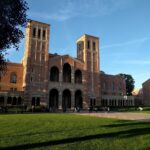Professing Against Proposition 8
The trial to decide whether California’s Proposition 8 was unconstitutional by banning same-sex marriage opened on January 11 before the United States District Court for the Northern District of California.
If the case moves on to the U.S. Supreme Court, the testimony from this trial will go along to inform the Justices’ decisions and, if the American Foundation for Equal Rights (AFER), “Plaintiffs’ Trial Witness List” is any indication, this means a significant portion of the testimony for, or against, declaring Proposition 8 unconstitutional will originate in the ivory tower.
The following professors are listed as witnesses by the plaintiffs in Perry v. Schwarzenegger:
- Economics professor M.V. Leed Badgett from the University of Massachusetts at Amherst;
- Harvard Professor Nancy F. Cott;
- Yale Professor George Chauncey;
- UT Austin Professor Daniel S. Hamermesh,
- UC Davis Professor Gregory M. Herek;
- Cambridge University Professor Michael Lamb;
- Columbia University Professor Ilan H. Meyer;
- UCLA Professor Letitia Anne Peplau;
- Stanford Professor Gary M. Segura;
- Louisiana State University Professor Loren Marks (“He purports to be knowledgeable about whether the ‘biological, marriage-based family [is] the ideal structure for child outcomes,’” writes AFER);
- McGill University Professor Paul Nathanson. (“He purports to be knowledgeable about religious attitudes toward Prop. 8.”) ;
- McGill University Professor Katherine Young. (“She purports to be knowledgeable about comparative religion and on what universally constitutes marriage,” states AFER);
- Oxford University Professor Daniel N. Robinson. (“He purports to be knowledgeable about sexual orientation,” they state.);
- Claremont McKenna College Professor Kenneth P. Miller (“He purports to be knowledgeable about political power.”);
- Simon Fraser University Professor Douglas W. Allen. (“He purports to be knowledgeable about the effects of same-sex marriage.”)
Just because the Supreme Court ruled that witnesses’ testimony will not be broadcast live doesn’t mean you can’t find out what these professors will be saying about gay marriage through the print media.
“Lawyers challenging Proposition 8 expect to wrap up their case Wednesday,” writes Maura Dolan with the Los Angeles Times on January 15, 2010. “The Proposition 8 campaign will then call witnesses to testify about historical and religious implications of marriage.”
Most of the listed professors supporting AFER’s agenda have already testified. Prof. Cott “drew connections between the current restrictions on same-sex marriage and former marriage restrictions, such as the laws that once forbade white women from marrying Chinese men and the infamous miscegenation laws repealed in 1967 that prohibited white women from marrying black men” in her Tuesday testimony, according to the Harvard Crimson.
“Cott responded in an e-mailed statement to The Crimson on Thursday that her point had not been about importance in any absolute sense but rather importance from the perspective of the state with the authority to create marriage rules.”
In the same vein, “Dr. Peplau told the court that the American Psychological Association has recently endorsed the idea that ‘satisfaction, stability and commitment is relatively the same between gay and straight,’” blogs Gerry Shih at The New York Times.
“After showing the video, the plaintiff’s attorney, Therese Stewart, asked Professor Chauncey if the history of public and media images of gays in the mid-20th century were relevant to Mr. Tam’s opinions,” writes Shih, continuing,
“The scholar said, ‘There’s a deep fear about simple exposure to homosexuality or to same-sex marriage that might will [sic] lead children to become gay.’
Professor Chauncey described it as ‘the kind of hostility and kind of arguments that have been made for several decades now.’”
Professor Lamb is scheduled to “discuss gay and lesbian parenting and the benefits to children of allowing same-sex couples to marry” today, according to an Associated Press article, whereas Prof. Meyer has testified “that gays and lesbians were more likely to suffer from mental disorders than heterosexuals because of discrimination,” according to Dolan.
“Proposition 8 sent ‘a message that gay relationships are not respected, that they are of secondary value if they are of any value at all,’ Meyer said,” writes Dolan. “He also said the 2008 measure made the public statement that it was OK ‘to designate gay people as a different class of people in terms of their intimate relationships.’”
Also on the witness list are members and leaders of the “Yes on 8” movement, which, according to AFER, may be called on to testify about “the genesis, strategy, and execution of the…campaign.”
To understand the dynamics of this case one can go back to Brown v. Board of Education, in which the Supreme Court ruled that segregated schools cannot be equal and ordered the integration of schools nationwide. “The [Theodore Olson and David Bois legal] team hopes for a ruling that will transform the legal and social landscape nationwide, something on the order of Brown V. Board of Education, in 1954, or Loving V. Virginia, the landmark 1967 Supreme Court ruling that invalidated laws prohibiting interracial marriage,” writes Margaret Talbot in her The New Yorker article “A Risky Proposal.”
Or, in the Supreme Court’s own words, “We come then to the question presented: Does segregation of children in public schools solely on the basis of race, even though the facilities and other “tangible” factors may be equal, deprive the children of the minority group of equal educational opportunities? We believe that it does.”
The Brown v. Board decision was also informed by academic research. (Note: This author is not commenting on potential and historical decisions in either case so much as the methods used therein). For example, City College of New York (CCNY) psychology professor Kenneth B. Clark and his wife produced research showing “four plastic, diaper-clad dolls, identical except for color. They showed the dolls to black children between the ages of three and seven and asked them questions to determine racial perception and preference,” states the Library of Congress website. “Almost all of the children readily identified the race of the dolls,” it states. “However, when asked which they preferred, the majority selected the white doll and attributed positive characteristics to it.”
In addition, “Many of the children with dark complexions colored the figures [of themselves] with a white or yellow crayon…The Clarks concluded that ‘prejudice, discrimination, and segregation’ caused black children to develop a sense of inferiority and self hatred.”
If the Supreme Court considered this evidence in Brown v. Board, then research such as that conducted by Prof.’s Meyer has the potential to inform a Supreme Court decision on Perry v. Schwarzenegger as well.
Bethany Stotts is a staff writer at Accuracy in Academia.




